Finding the Right Camp for A First-Timer
April 15, 2024

By Daniel Franklin, Ph.D.
Getting and staying organized requires a broad range of executive functioning skills, time, and energy that your child may not have. Routinely engaging in organizational tasks with you, your child will become familiar and comfortable with organizational routines.
Let’s start with one of the most common organizational problems students with ADHD have: backpacks.
Disorganized backpacks are the root of more school difficulties than you can imagine. One reason an organized backpack is so crucial to school success is the impression it makes on a teacher. When a teacher sees that a student’s backpack is not neat, it can send the message that the child is not a hard worker.
A disorganized backpack also makes it hard for children to quickly locate homework, find the correct folders for each subject, and pull out materials to record assignments.
Many parents have been taught that keeping a backpack organized should be their child’s responsibility. Ultimately, it will be, but children with ADHD need considerable time, modeling, and instruction to develop all of the capacities that staying organized requires.
Real-World Example: Having found that a backpack is often the best starting place, I asked Lisa [an 8th grader with a reading disability and ADHD] if we could first organize her backpack, which was in complete disarray. It was filled with old assignments and papers that dated back to the previous school year. In order to involve her in this task, I held up each sheet of paper and allowed her to decide if it was (a) to be kept in her backpack, (b) hole-punched and put in a binder, (c) filed away, or (d) recycled. I did the manual component of organization for her because I wanted her to focus solely on decision making.
Modeling is key for children with ADHD. By being your child’s organizer and providing an organizational strategy, you will help your child learn to take care of him- or herself. Ultimately, your child will develop a template for what it means to be organized; for the first time, perhaps, your child will experience what a tidy backpack actually looks like. This new, neat template, in contrast to the chaotic one, often takes weeks or months to get the hang of. But once internalized, your child will be prepared to do the sorting on his or her own.
The process used for keeping your child’s backpack orderly can also be applied to your child’s workspace at home. Sit together at your child’s study area at least once a week and work together to make sure all supplies are stocked, trash is cleared, virtual and physical folders and desktops are organized, and required reading materials are accounted for. Familiarity and repetition with this organizational routine will eventually lead to a habit of neatness.
For more tips on providing organization support see the Free Tools For Helping Your Child with Language-Based Learning Disabilities on the book publisher’s website.
This post is excerpted from Helping Your Child with Language-Based Learning Disabilities (Strategies to Succeed in School and Life with Dyscalculia, Dyslexia, ADHD, and Auditory Processing Disorder), by Daniel Franklin, PhD; published by New Harbinger Publications (2018). Available at Amazon through this link: Helping Your Child with Language-Based Learning Disabilities. Dr. Franklin is a Board Certified Educational Therapist and the founder of Franklin Educational Services.